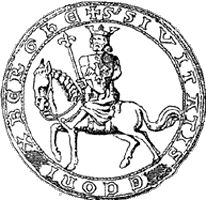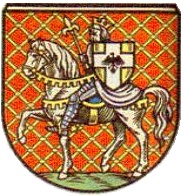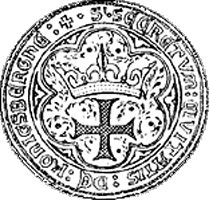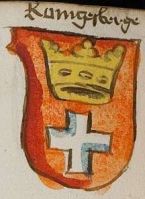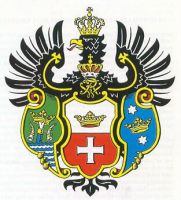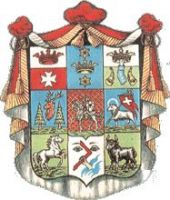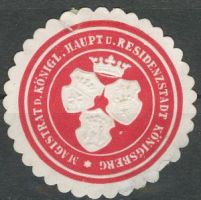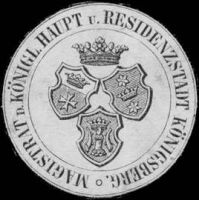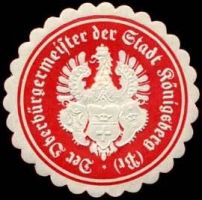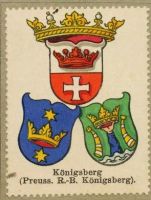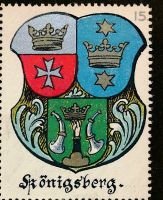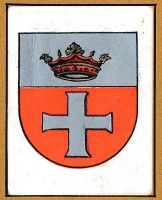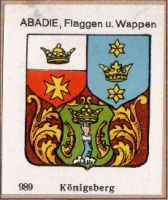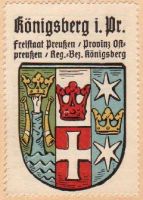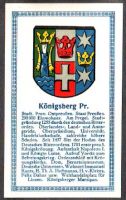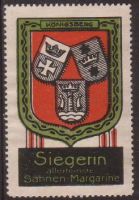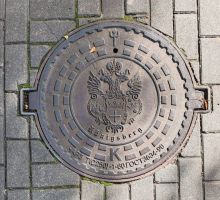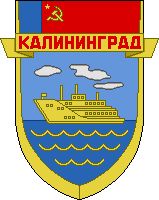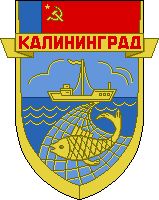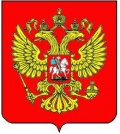Kaliningrad
|
КАЛИНИНГРАД Country : Russia Federal subject : Kaliningrad Oblast Additions: (to see click on expand)
|
| Russian | В лазоревом поле серебряный корабль с одним парусом и с серебряным вымпелом о двух концах, обременённым лазоревым Андреевским крестом, на мачте, прорастающей внизу тремя зелёными листами; в оконечности — золотые безанты, уложенные в волнистый, о двух волнах, пояс и уменьшающиеся к краям. Сердцевой щиток пересечён серебром и червленью; вверху — корона, внизу — уширенный на концах (греческий) крест, обе фигуры переменных цветов. Щиток окружён лентой медали «За взятие Кенигсберга». Парусник на гербе Калининграда символизирует связь анклавной территории Калининграда с остальной территорией России. |
| English | blazon wanted |
Origin/meaning
The modern Kaliningrad adopted arms on July 17, 1996, shown above. The arms show the old (small) arms surrounded by a ship, indicating the importance as a harbour town. The ship is shown as a medieval ship, as shipping has been of importance for the town during its whole existence.
Kaliningrad was founded as Königsberg by the Teutonic Knights in 1255, advised by King Ottokar of Bohemia. 1255. They called it after him 'The Kings mount' or 'Königsberg' in German. Around it a city grew that acquired city rights in 1286.
The city had in the fourteenth century a seal with a knight on horseback, which also appeared on the arms. The knight held a small shield with the arms of the Teutonic Knights. In 1450 a seal appears showing a shield parted horizontally silver and red. The silver upper half shows an open red crown. The lower red half shows a silver cross. The shield is covered with a helmet and two savages act as supporters. See images below. The crown and cross probably symbolise the King and the Order.
In 1724 Königsberg incorporated the two neighbouring cities Kneiphof and Löbenicht and new arms were needed. In the new arms of the combined Königsberg the arms of the three cities were sometimes shown together in a single shield, but more often shown separately, with the Prussian eagle as a supporter, see images further below.
In 1809 under Napoleonic rule, new arms were designed, combining the arms of the three cities with those of several settlements which were incorporated into the city. The arms show in the upper row the arms of the three cities 'Altstadt', Löbenicht and Kneiphof, in the middle row Tragheim, Königsberg (before 1450) and Sackheim, the lower row Vorderroßgarten, Hinterroßgarten and Neue Sorge. After the defeat of Napoleon the old arms were restored and used until 1945.
Königsberg was the capital of East Prussia until 1945, when it became part of Russia. Ever since the city is named Kaliningrad. The new city of Kaliningrad after 1945 did not have proper arms of symbols until 1996, but some 'arms; were used on souvenir badges etc, see images below.
Image gallery
The arms in an album from around 1905
The arms in an album from around 1910
The arms in the Kurmark Wappenschau album from 1929
The arms in the Abadie albums
The arms by Hupp in the Kaffee Hag albums +/- 1925
The arms as seen in the Abdulla-Deutsche Städtewappen album
The arms on a Siegerin Margarine trade stamp
Literature : Hupp, O; 1893; Soboleva, 1998; http://www.heraldicum.ru
Russia heraldry portal
This page is part of the Russia heraldry portal |
Heraldry of the World |
|
Civic heraldry:
|
Other heraldry: |
Contact and Support
Partners:
Your logo here ?
Contact us
© since 1995, Heraldry of the World, Ralf Hartemink 
Index of the site



